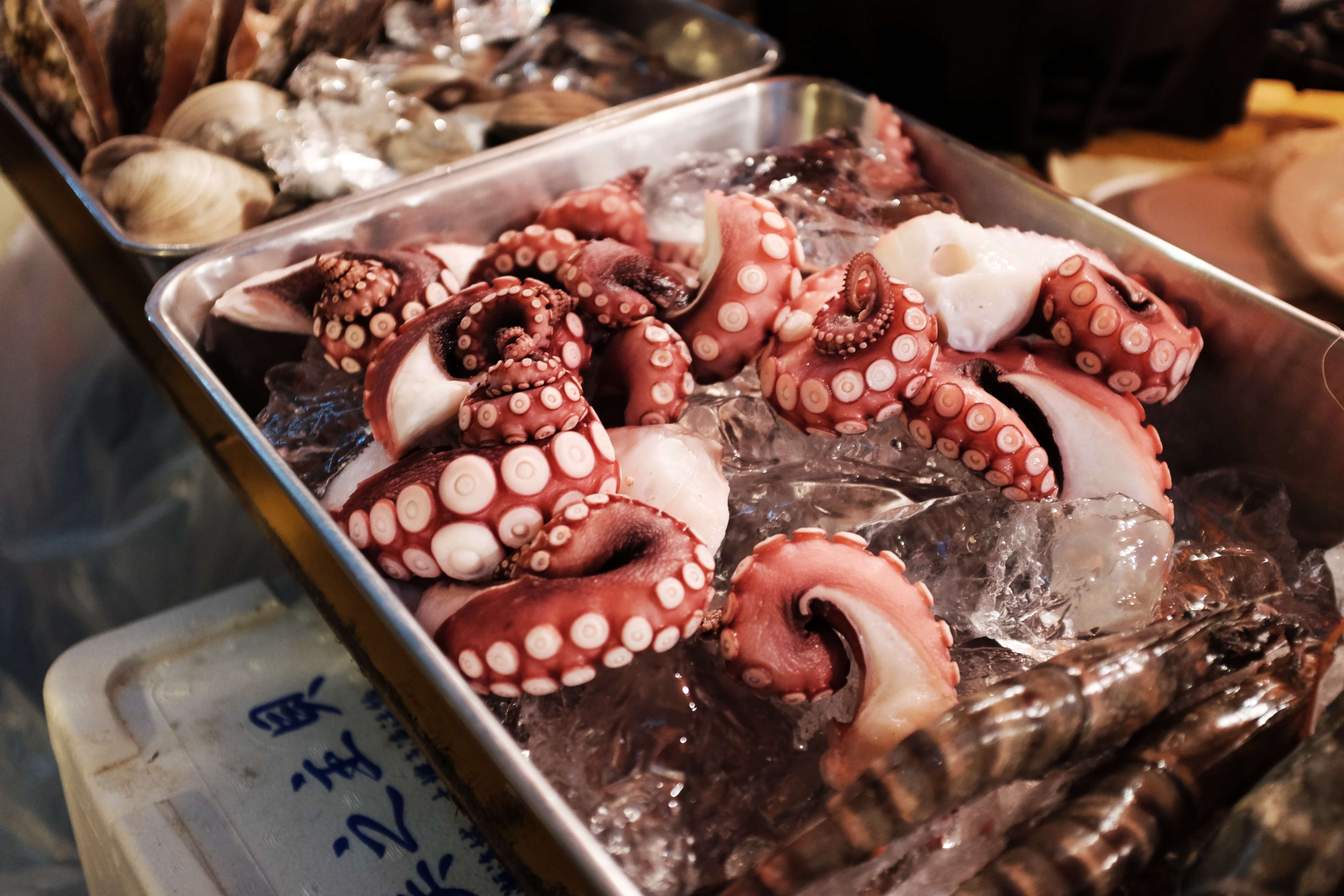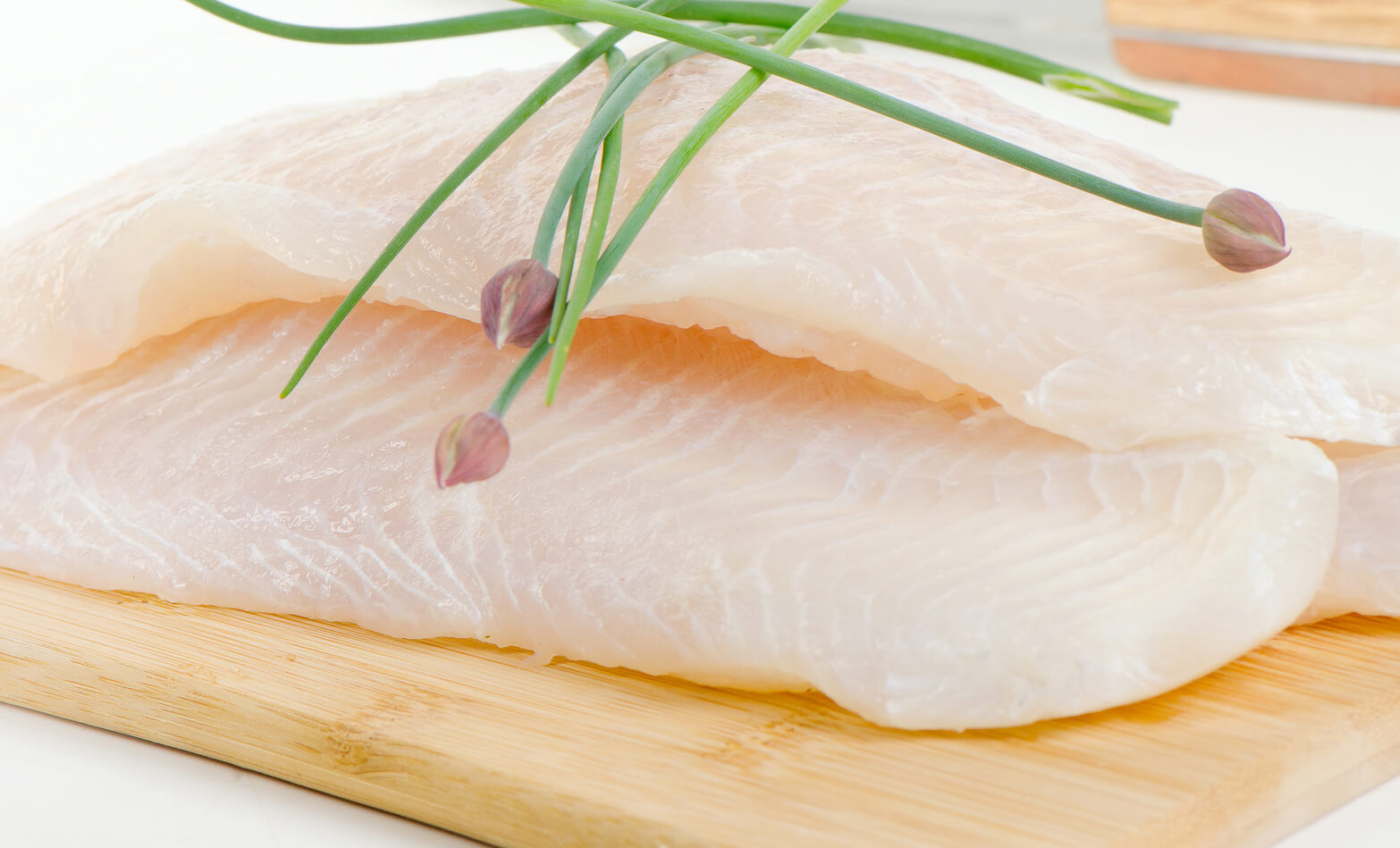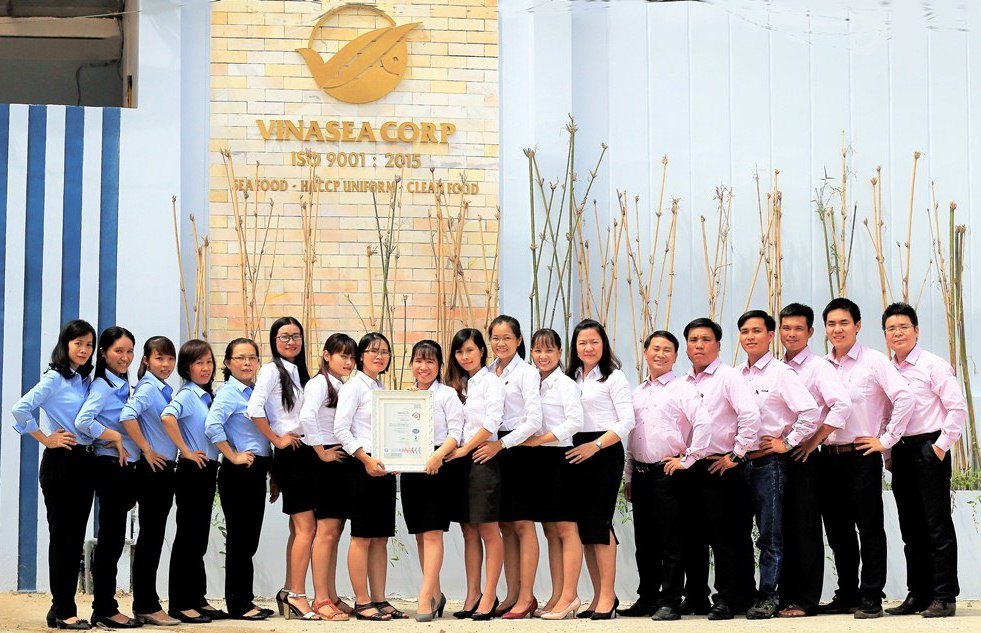CO-OPERATION MANUFACTURERS NETWORK
With 20 years experience in the field of seafood business and provide uniforms and protective wear for seafood industry, we have build a good relationship with over 300 seafood manufacturers in Vietnam. In particular, we are working closely with more than 25 selected seafood manufacturers to produce hundred high quality seafood items under VINASEA brand and customers brand (OEM). We believe that VINASEA can meet all the requirements of customers with high quality products on-time delivery traceability capable and most competitive price.
WHY CHOOSE US AMONG HUNDREDS SEAFOOD EXPORTERS IN VIETNAM?
 20 YEARS: EXPERIENCE IN VIETNAM SEAFOOD BUSINESS.
20 YEARS: EXPERIENCE IN VIETNAM SEAFOOD BUSINESS.
 25 RELATION MANUFACTURES NETWORK: CAN SUPPLY ALL YOUR NEEDED SEAFOOD FROM VIETNAM.
25 RELATION MANUFACTURES NETWORK: CAN SUPPLY ALL YOUR NEEDED SEAFOOD FROM VIETNAM.
 200 SHIPMENTS EVERY YEAR: QUALITY SATISFACTION AND IN-TIME DELIVERY.
200 SHIPMENTS EVERY YEAR: QUALITY SATISFACTION AND IN-TIME DELIVERY.
 100% CUSTOMER'S COMPLAINS: QUICK RESPONSE AND IMMEDIATE IMPROVEMENT ACTIONS.
100% CUSTOMER'S COMPLAINS: QUICK RESPONSE AND IMMEDIATE IMPROVEMENT ACTIONS.
 1ST SEAFOOD COMPANY IN VIETNAM: APPLY ON-LINE TRACKING SYSTEM (OTS) AND QUICK RESPONSE TRACEABILITY SYSTEM (QRTS).
1ST SEAFOOD COMPANY IN VIETNAM: APPLY ON-LINE TRACKING SYSTEM (OTS) AND QUICK RESPONSE TRACEABILITY SYSTEM (QRTS).
- Details
- Written by Super User
- Category: NEWS
- Hits: 1370
Supplies of octopus and squid appear to be tighter this year. As a consequence, prices have started to go up and they will keep rising. The developing trade war between the United States of America and China is also contributing to problems.

Octopus
There was a lack of octopus in the market in the spring this year. Landings both in Morocco and Mauritania were low. The lack of supplies pushed prices up dramatically.
Morocco’s octopus season was delayed by one month until 30 June. The Government took this action after consulting with the industry. Last season, only 65 percent of the total quota was landed. Catches have been declining for some time and the delayed season is an attempt to improve the resource.
The Sustainable Fisheries Partnership (SFP) has announced that it has established a fishery improvement project in order to promote sustainable octopus fishery in Mauritania. The Mauritanian octopus fishery is an important source of supply to the global cephalopod market, and it is desirable to bring this fishery to a sustainable state.
The Scientific Certification Systems Global (SCS Global) has been undertaking a pre-assessment of the sustainability of an octopus fishery off the coast of the Yucatan Peninsula in Mexico. The octopus fishery and the red grouper fishery represent the most important resource in this region, with an annual catch fluctuating between 9 000 and 16 000 tonnes.
Trade
Octopus prices on world markets have been very high recently. In April, prices on the US market were 28 percent higher that in 2016, according to Spanish exporter Discefa. Prices for Moroccan frozen on board octopus reached USD 17.00 per kg for size T1.
Viet Nam’s exports of octopus and squid are increasing dramatically this year. According to figures published by the Viet Nam Association of Seafood Exporters and Producers (VASEP), exports of cephalopods to the Russian Federation during the first three months of 2018 amounted to over USD 1 million, up almost nine times compared to the same period in 2017. The Russian Federation is now one of the most important markets for Vietnamese octopus and squid, and accounts for more than 90 percent of the export value of Viet Nam’s octopus.
Japanese imports of octopus in the first quarter of 2018 totalled to 8 900 tonnes, slightly up compared to 2017. However, there were changes in the suppliers. Morocco and China experienced reduced shipments to Japan, while Viet Nam saw an increase.
Korean imports of octopus have been on a declining trend for some time, but during the first three months of 2018, the trend levelled off. Imports during this period in 2018 amounted to 16 400 tonnes, just 4.5 percent less than in 2017.
Squid
The Peruvian Ministry of Production (PRODUCE) set the quota for the 2018 giant squid fishery at 609 000 tonnes. This quota may be changed later, based on recommendations from the Maritime Institute of Peru (IMARPE). The stock is in good shape, according to the Ministry. Average annual catches of giant squid in Peru have been around 500 000 tonnes for several years.
Illex squid catches inside Argentine waters have been good. During the first three months of the year, Illex catches were up by 15 percent over last year. This fishery started earlier than usual this year because many Chinese and Taiwanese vessels were already active just outside the Argentine exclusive economic zone (EEZ). During the second quarter of the year there have been reports of very poor production.
For the Chinese (mainland and Taiwan Province) vessels operating outside the EEZ, the shortfin squid fishery has been disappointing. As the fishery drew to a close in late April, vessels operating in international waters off Argentina had caught 110 000 tonnes of squid. This was just half of the volume caught by these vessels in 2017. Observers expected prices to rise as a consequence. Much of this catch was destined for China, and Chinese prices for squid were already rising in late April.
The Loligo fishery in the Falkland Islands (Malvinas) also started very well. During the first month some 20 000 tonnes were landed. A survey carried out in February indicated that there were aggregations of small squid only in the southern region. Soon after the fishery started, larger aggregations of squid were found also in the north. Because of the smaller size of the squid found in the south, this fishery was closed for a week at the end of March for conservation purposes.
Trade
Poor catches by Chinese vessels operating just outside the Argentine EEZ contributed to increasing prices of practically all species of squid in China. Reported catches per vessel were down to 300¬500 tonnes, while average catch per vessel last year was about 800 tonnes. Prices were up by 2¬6 percent in mid-April compared to the beginning of 2018. Prices for Todarodes pacificus squid, which is caught mainly in East Asia, were also up.
US President Trump’s trade war is creating negative effects for US seafood exporters even before it is in effect. Chinese squid importers stopped ordering US squid because they feared shipments would not reach them before the 25 percent extra import tariff goes into effect in mid-July. This is also unfavourable for the US squid industry. In 2017, about half of the US exports of squid went to China. China imported 34 700 tonnes of squid worth USD 92.8 million. The second largest importer of US squid was Viet Nam, which imported 8 900 tonnes, and the third largest importer was Japan, with 8 100 tonnes. Chinese importers are looking for other suppliers, which are difficult to come by because of lower production overall. Consequently, squid supplies may be very tight in the coming months, and prices will be high.
Japanese imports of squid and cuttlefish marginally declined during the first three months of 2018 compared to the same period in 2017. Total imports of these species went down from 36 400 tonnes in 2017 to 30 900 tonnes in 2018 (-15.1 percent). China is by far the largest supplier, accounting for 73.4 percent of the total.
China exported 12 percent more squid and cuttlefish in the first three months of 2018 than in the same period in 2017. Total exports amounted to 131 100 tonnes. The main markets were the Republic of Korea, Japan and Thailand. Chinese imports of the same products remained level. Total imports of squid and cuttlefish during the first quarter of the year reached 42 000 tonnes, with Indonesia and the United States of America being the two main suppliers.
Spanish imports of squid and cuttlefish declined from 57 300 tonnes during the first three months of 2017 to 50 900 tonnes during the same period in 2018 (-11.2 percent). The main reductions were registered in exports from “other countries”, while the main supplier, China, held its own, and the second largest supplier, the Falkland Islands (Malvinas), increased its shipments by 262 percent.
US imports of squid and cuttlefish during the first three months of 2018 declined slightly by 1.3 percent to 17 700 tonnes. Imports from the largest supplier, China, accounted for as much as 61.7 percent (10 900 tonnes). Other major suppliers included India (10.4 percent of total) and Taiwan Province of China (7.6 percent of total).
Outlook
The cephalopod market should expect tight supplies, especially for squid, but also for octopus. While catches inside Argentina’s EEZ have been fairly good, catches by foreign vessels outside this EEZ have been poor. In addition, the developing trade war between the United States of America and China is creating supply problems. Prices have come up noticeably, and may go further up.
- Details
- Written by Super User
- Category: NEWS
- Hits: 1691
Continuing the trend of 2017, Viet Nam’s exports of pangasius to China were up 45 percent by value in the first quarter of this year, reaching USD 101 million as prices increased. In the United States of America, the strict inspections regime combined with tariff hikes is inhibiting Vietnamese access to the market.
Viet Nam’s pangasius export revenue has traditionally been primarily comprised of sales in the core markets of the United States of America, EU28 and China, as well as some smaller markets in the Association of Southeast Asian Nations (ASEAN) region. In recent years, the relative shares of the three major markets has been changing, This shift began around a decade ago with a sharp decline in sales in the EU28 after negative media coverage and heavy competition in the whitefish category. It has continued in more recent times with the effects of various trade barriers on US import volumes.
Most recently, revenue from a fast-evolving Chinese market has been climbing rapidly, sustaining a rising price trend worldwide on limited supply growth. Early in 2018, the Vietnam Association of Seafood Exporters and Producers (VASEP) indicated a target of USD 2 billion in pangasius export revenue for the year, of which some 25 percent is expected to come from Chinese sales.

Viet Nam
VASEP’s export revenue target for pangasius this year would require a total production of 1.3 million tonnes of fish, marginally above last year’s figure of 1.25 million tonnes. However, an ongoing fingerling shortage and volatile temperatures saw harvests reduced in the few months of the year, increasing the competition for raw material amongst processors and driving prices higher. Farmgate prices in this range offer appealing profit potential to Vietnamese fish farmers. As a result, pangasius breeding areas have been expanded in the Mekong Delta, particularly in the major pangasius producing province of Dong Thap. In Long An Province, authorities have had to warn local rice farmers not to breed fish in unzoned areas.
According to VASEP reported figures, Viet Nam exported pangasius worth USD 440 million in the first quarter of the year, with spiking prices ensuring that almost all destinations registered increases compared with the same period in 2017. While exports to China increased by 45 percent, the ASEAN region saw its imports of Vietnamese pangasius increase by 56.5 percent, led by Thailand, Singapore and the Philippines. The ASEAN bloc has already overtaken the EU28 in terms of market share, and on its current trajectory it will overtake the United States of America in a few years, particularly given the barriers hindering US imports of Vietnamese pangasius. One of these barriers has been the implementation of a new food safety inspection procedure in late 2017, which prompted the Vietnamese authorities to file a complaint at the World Trade Organization (WTO) that the regime constituted an unfair trade practice.
United States of America
In addition to the food safety inspection regime that has seen some US-destined pangasius shipments halted, the United States of America also recently increased anti-dumping duties levied on imports of Vietnamese pangasius fillet. In March this year, these duties were raised significantly from USD 2.39 per kg to USD 3.87 per kg, with some exporters subject to even higher tariffs of up to USD 7.74 per kg. With prices already being driven up globally, the additional restrictions on raw material supply in the United States of America have accentuated the trend. Although exporters are now exploring marketing for alternative product forms, the high price level is inevitably suppressing buyer demand and increasing the appeal of competing whitefish options such as Alaska pollock.
China
The popularity of pangasius in the Chinese market is underpinned by rapid growth in demand for whitefish products and helped by its strengthening competitive advantage when compared with domestically produced tilapia, the main competitor. Viet Nam has extensive trade links with China and its farmed pangasius is positively perceived by consumers, generating interest from buyers seeking a commodity whitefish as well as from those looking for value-added finished products that emphasise quality. This has seen Viet Nam’s reported pangasius annual exports to China grow from around USD 50 million in 2011 to almost USD 400 million last year.
European Union (Member Organization)
The decline of pangasius is ongoing in the EU28 market, with the value of Viet Nam’s EU28-destined exports falling by over half in the last 5 years. The effects of weak consumer demand, damaging media coverage and strong competition from whitefish alternatives have now been compounded by the high price level. However, there is one notable exception to the prevailing trend – the United Kingdom. According to VASEP, the United Kingdom was the only EU28 market to register an increase in pangasius imports in 2017, reaching USD 46 million after a 2.5 percent increase.
Other markets
In addition to the rising consumption in the Southeast Asian region, demand for pangasius is increasing in a diverse range of markets across Latin America, South Asia and the Middle East. Income growth, urbanization and stagnating capture fisheries in these emerging markets mean that a farmed, versatile finfish such as pangasius is well positioned for future growth.
Outlook
Total pangasius production growth is expected to be low or flat in 2018. Despite the difficult market environment in the United States of America and the EU28, demand from China and smaller markets should be more than sufficient to keep prices high for the remainder of the year. Indeed, in the second quarter, raw material prices reached some of the highest levels ever seen, in the region of VND 31 000–33 000 (USD 1.37–1.43) per kg, representing an increase of around 25 percent compared with the same period last year. Meanwhile, average pangasius fillet export prices to the US market were about 50 percent higher in the first half of 2018 compared with the same period in 2017.
However, the future output resulting from increased production activity will inevitably have an effect on these price levels, and as of mid-2018 the trend had turned downwards once again with the start of the breeding season. In an extreme scenario, if these price-driven production hikes by suppliers are overly rapid, they represent a potential risk to market stability.
In the longer term, the positive demand outlook is dependent on the ability of the Vietnamese industry to maintain their position in a fiercely competitive Chinese market and also, more broadly, on a continuation of the generally strong economic situation globally that is supporting import growth in alternative markets. Vietnamese stakeholders have also been quick to identify the risk associated with overdependence on the Chinese market and have indicated their intention to plan accordingly.
- Details
- Written by Super User
- Category: NEWS
- Hits: 4301
Ngày 24.10.2015 vừa qua, tập đoàn VINASEA CORP đã long trọng tổ chức lễ kỷ niệm 10 năm ngày thành lập công ty tại tòa nhà VINASEA CORP 09 pasteur, Nha Trang. Buổi lễ có sự hiện diện của các thành viên hồi đồng quản trị, Ban Giám Đốc cùng toàn thể Anh Chị Em cán bộ công nhân viên công ty Vinasea và những thành viên sáng lập, những cán bộ đã từng gắn bó với công ty trong thời gian dài. Đặc biệt công ty cũng vui mừng đón tiếp những vị khách mời là đối tác lâu năm trong và ngoài nước.

Phát biểu khai mạc buổi lễ, ông Phạm Hoàng Hải , chủ tịch hội đồng quản trị đã có những chia sẻ về chặng đường 10 năm phát triển và trưởng thành của công ty, với những khó khăn và thử thách, cũng như lời khẳng định về sự thành công và lớn mạnh trong tương lai. Với mục tiêu hoạt động : luôn làm cho khách hàng thỏa mãn và tin cậy vào Vinasea cung cấp sản phẩm có chất lượng cao, chất lượng dịch vụ tốt với những đội ngũ nhân viên trẻ, sáng tạo.
Tiếp theo là bài phát biểu của các vị khách, các đối tác tới tham dự buổi lễ của công ty Ông Lê Hoài Phương , Giám đốc kinh doanh đại diện cho các cán bộ công nhân viên công ty lên phát biểu cảm nghĩ và thể hiện sự quyết tâm đóng góp vào sự phát triển của công ty…
Buổi lễ đã thành công tốt đẹp, mang đến cho người tham dự những dư âm của quá khứ, sự lớn mạnh của đội ngũ nhân sự hiện tại và cùng tin tưởng vào một tương lai vững mạnh.













